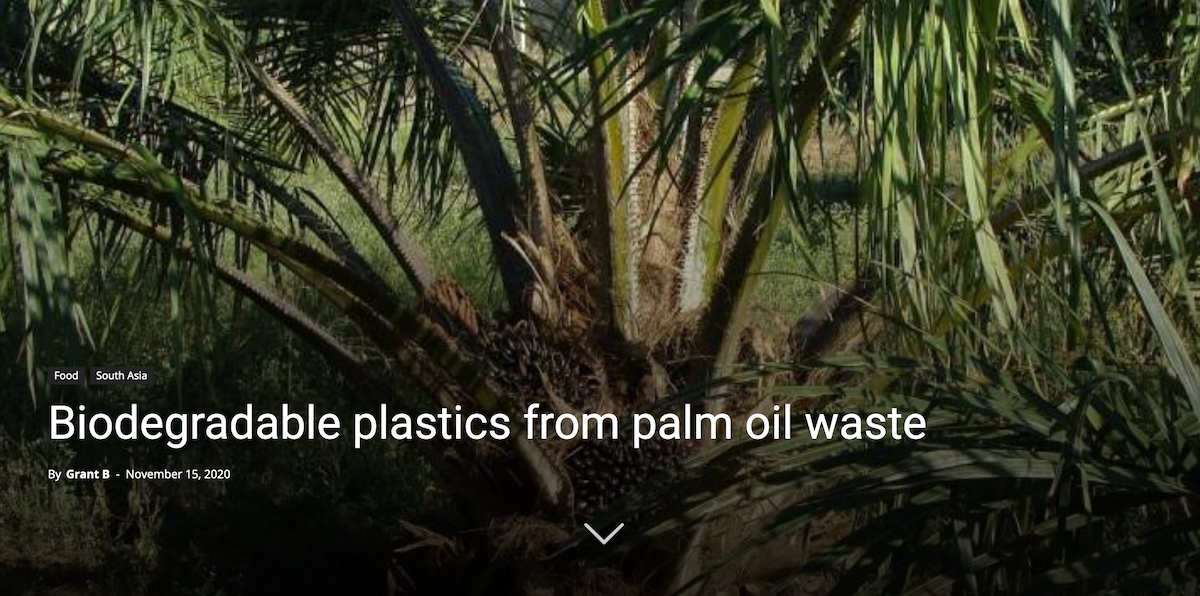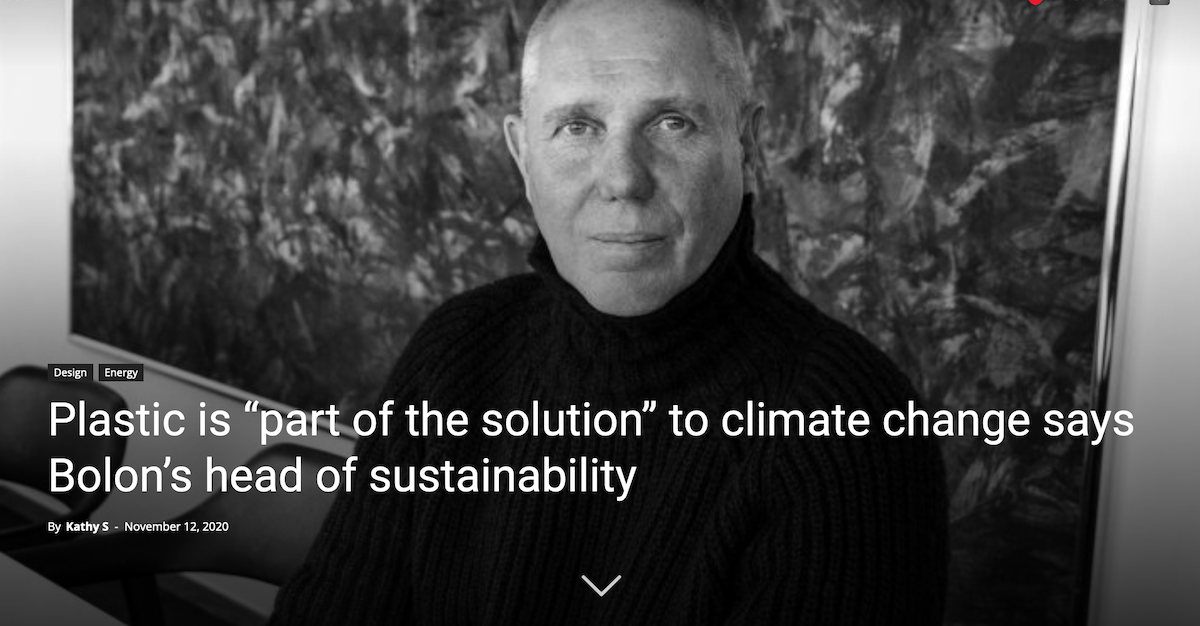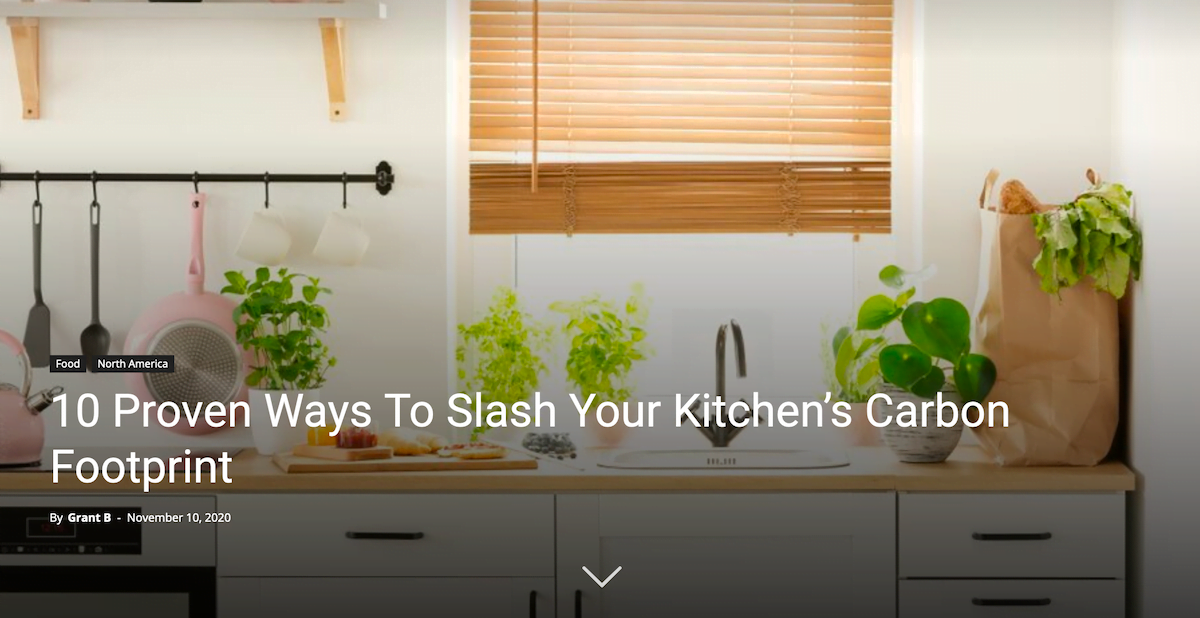Hidden Chameleons and Plastic Solutions
Top 5 Happy Eco News – 2020-11-23
Before we get to the Top 5 this week, some housekeeping is in order.
Happy Eco News – Company News
Change is coming! In this case, I mean changes to Happy Eco News. We’ve been growing and gaining momentum, and as a result, we have a few new announcements:
- Introducing our content manager Kathy Smith! Kathy has been working behind the scenes for several weeks now, contributing articles to the site and editing content as required. Read more about Kathy on the Team Page.
- A new partnership with Ailuna. Ailuna is an online platform that helps you develop habits that are good for you and the planet. They offer challenges, games, tips, tricks, and eco-friendly consumer products to help people in their daily lives. Happy Eco News will be providing them with stories for their news feed on their website and app. Check them out at Ailuna.com.
- A new podcast update on Mother Daughter Earthcast (the link is to my first interview with them). Release date TBD.
- A new Happy Eco News logo. The existing logo is difficult to reproduce in smaller sizes or with only one colour. We will be updating it to make it easier for third-party vendors to work with (coming soon).
- Advertising – we are looking at joining some advertising programs that will provide revenue via tasteful ads that will be helpful to you, the Happy Eco News audience (coming soon).
- Patreon – Support Happy Eco News. Patrons will have access to special programs like group meetups, direct messaging with Grant, and exclusive Happy Eco News merchandise (coming soon).
It is our intention to continue to provide quality content that will always be free for our audience.
Stay happy…
—
Blog – You’ll die of old age, I’ll die of climate change
Blog Post by Grant Brown, Founder, Happy Eco News.
 I was absently browsing the web looking for inspiration for a good blog post this afternoon, doomscrolling is what I think my kids would call it (at least that’s what it feels like). I wasn’t motivated to write, having had a kind of crappy week. Covid lockdowns, rising death rates, and fear everywhere kind of does that to my creative process. After an hour of uninspired content, I saw an image of a woman, a protester, carrying a hand-printed sign that said, “You’ll die of old age, I’ll die of climate change”.
I was absently browsing the web looking for inspiration for a good blog post this afternoon, doomscrolling is what I think my kids would call it (at least that’s what it feels like). I wasn’t motivated to write, having had a kind of crappy week. Covid lockdowns, rising death rates, and fear everywhere kind of does that to my creative process. After an hour of uninspired content, I saw an image of a woman, a protester, carrying a hand-printed sign that said, “You’ll die of old age, I’ll die of climate change”.
Upon closer scrutiny, the woman is young. Close in age to my own daughter, she is a teen probably 17 or 18 years old (maybe younger) and in the photo, it appears she has a half-smile. Her hair is wet, her feet barefoot. Eyes locked on the photographer, she walks toward the camera, away from the direction the other protesters are walking.
She is our future.
She, and others like her, are the people who will be most affected by the climate crisis. If recent trends continue, people my age will mostly… [read more]
The Happy Eco News – Weekly Top 5:
1) Chameleon last seen a century ago rediscovered in Madagascar
 Imagine a small lizard, so elusive that it has only been documented a handful of times, most recently over 100 years ago. The Voeltzkow’s chameleon of Madagascar is such an animal. It is believed to live for only a few months during the rainy season, completing its entire life cycle during this time. It Hatches from eggs, grows to maturity, finds a mate, reproduces, and dies in just a few short months. Furcifer Voeltzkowi is found only in northwestern Madagascar and likely lives in the large, relatively undisturbed mangrove forests there.
Imagine a small lizard, so elusive that it has only been documented a handful of times, most recently over 100 years ago. The Voeltzkow’s chameleon of Madagascar is such an animal. It is believed to live for only a few months during the rainy season, completing its entire life cycle during this time. It Hatches from eggs, grows to maturity, finds a mate, reproduces, and dies in just a few short months. Furcifer Voeltzkowi is found only in northwestern Madagascar and likely lives in the large, relatively undisturbed mangrove forests there.
Why it’s important: The rediscovery of such a species provides hope to researchers that other extinct species from the same area may still have breeding populations. The short lifespan and elusive nature of these and two other lost chameleon species – the Toothed Leaf Chameleon (Brookesia denata) and Chamaeleon grandidieri – are from the same area, and it is thought that a targeted expedition may rediscover one or both.
The proof that wild forests hold undiscovered or so-called lost species is exciting as they provide crucial data for conservation measures and also bring some hope amidst the biodiversity crisis. It is a very thrilling idea for many scientists, researchers, and nature enthusiasts to think that it is still possible to find these rare and elusive creatures. Their documented existence can lead to increased protection for these threatened places and species. [read the article]
2) A mountain of a reef, taller than the Eiffel Tower, found on Great Barrier Reef
 A rare and huge detached coral reef over a kilometer tall was found in the sea off of Australia, just North of Queensland on October 21 of this year. The reef was the most recent to be discovered; there are others like it, but this was the first detached reef of that size to be discovered in over 120 years. Best of all, it was intact and thriving with fish in a healthy ecosystem. The new reef is nearby the Great Barrier Reef and is located on Australia’s northeast coast.
A rare and huge detached coral reef over a kilometer tall was found in the sea off of Australia, just North of Queensland on October 21 of this year. The reef was the most recent to be discovered; there are others like it, but this was the first detached reef of that size to be discovered in over 120 years. Best of all, it was intact and thriving with fish in a healthy ecosystem. The new reef is nearby the Great Barrier Reef and is located on Australia’s northeast coast.
Why it’s important: The Great Barrier Reef is approximately half the size of France by area. It is a UNESCO world heritage site and is known as the most extensive and spectacular coral reef ecosystem on the planet. Unfortunately, it has been in the news lately due to a mass die-off of the coral that creates it. A coral reef is a living entity made up of billions of organisms that require specific conditions to survive. In the locations where it is found, it has evolved to thrive specifically there. When ocean conditions change or pollution is introduced, the coral begins to die off. Scientists recently found that the Great Barrier Reef had lost more than half its coral in the last three decades. It is very encouraging to know that there are intact coral reefs to study and document using modern science and methods. The knowledge gained may then be used to help protect other reef ecosystems around the world. [read the article]
3) Biodegradable plastics from palm oil waste
 The trees that provide us a harvest of palm oil are often grown in areas that for millions of years were untouched forests. These are areas that are known for high biodiversity, carbon sequestration, and oxygen production. They are of great international concern as these areas are often referred to as the “lungs of the planet”, and it is vitally important that we maintain these forests as intact as possible. But the reality is we won’t likely be able to replant or rewild all of these areas, and consumer demand for palm oil is not likely going away any time soon. So, when life gives you lemons, make lemonade. Or in this case, hemicellulose. Hemicellulose is the by-product of palm oil production and until now was considered a waste product to be disposed of in one way or another.
The trees that provide us a harvest of palm oil are often grown in areas that for millions of years were untouched forests. These are areas that are known for high biodiversity, carbon sequestration, and oxygen production. They are of great international concern as these areas are often referred to as the “lungs of the planet”, and it is vitally important that we maintain these forests as intact as possible. But the reality is we won’t likely be able to replant or rewild all of these areas, and consumer demand for palm oil is not likely going away any time soon. So, when life gives you lemons, make lemonade. Or in this case, hemicellulose. Hemicellulose is the by-product of palm oil production and until now was considered a waste product to be disposed of in one way or another.
Why it’s important: Hemicellulose is abundant in agricultural biomass waste. When processed, it may be used as a biopolymer for plastic film manufacturing applications. It is flexible, has low gas permeability, and has high water resistance. Hemicellulose no longer requires costly disposal as it now has value, and as a result, it brings additional prosperity to the people who live in these regions. Further, because the plastic film that is created with it is a natural plant-based substance, in proper conditions it will biodegrade in a few months, unlike the traditional plastic film that simply breaks down into smaller and smaller particles that can cause issues with wildlife and human health. [read the article]
4) Plastic is “part of the solution” to climate change says Bolon’s head of sustainability
 “I think that plastic is a part of the solution,” said Håkan Nordin, a former climate activist who co-founded the Swedish branch of Greenpeace. Nordin, now head of sustainability for Swedish flooring company Bolon, says that plastic is a product that can be used sustainably and with a very small carbon footprint. There is no doubt that oil-based plastic is versatile, strong, and lightweight. It is easy to form into virtually any shape and can even be 3D printed to make limited production runs or prototype items economically. Using newly developed recycling processes that allow existing plastic to be recycled at the molecular stage and incorporated into new products would reduce the need for further oil extraction and may even create markets for plastic removed from the environment. In the case of structural use in buildings, the extremely long expected lifespan of the product makes it easy to see how it has a smaller footprint than other types of materials. Other building materials, such as steel, concrete, and asphalt have a very high carbon footprint because the products are very difficult to recycle and require huge energy inputs to do so. At end of life, they usually end up as waste.
“I think that plastic is a part of the solution,” said Håkan Nordin, a former climate activist who co-founded the Swedish branch of Greenpeace. Nordin, now head of sustainability for Swedish flooring company Bolon, says that plastic is a product that can be used sustainably and with a very small carbon footprint. There is no doubt that oil-based plastic is versatile, strong, and lightweight. It is easy to form into virtually any shape and can even be 3D printed to make limited production runs or prototype items economically. Using newly developed recycling processes that allow existing plastic to be recycled at the molecular stage and incorporated into new products would reduce the need for further oil extraction and may even create markets for plastic removed from the environment. In the case of structural use in buildings, the extremely long expected lifespan of the product makes it easy to see how it has a smaller footprint than other types of materials. Other building materials, such as steel, concrete, and asphalt have a very high carbon footprint because the products are very difficult to recycle and require huge energy inputs to do so. At end of life, they usually end up as waste.
An efficient circular economy using renewable energy would allow plastics to be reused over and over again with very few new inputs, reducing the total net carbon footprint of the plastic each time.
Why it’s important: Plastic is not evil; it has fueled the growth of human society like no other substance. It is everywhere we look and in almost every product we use. In the last 60 years, humans have produced 8.3 billion metric tons of it. Unfortunately, 6.3 billion metric tons has become waste, and of that, only nine percent have been recycled. Other than being broken into smaller fragments, the rest still exists in its original form somewhere on the planet. The problem lies in the fact that we have not had any reason to recycle it until now. Sure, product labels all have recycling instructions, but without meaningful access to actually make that happen, the stuff just accumulates. To a manufacturer, recycled plastic is an inferior product that costs more to use. Now there is a clear reason and opportunity to begin using plastic in a circular economy to benefit society. Single-use plastic is a scourge almost everywhere on earth and now we are finally able to do something productive with it. [read the article]
5) 10 Proven Ways To Slash Your Kitchen’s Carbon Footprint
 When we talk about climate and society here in the West, we often tell other people they should change. That they should change their habits in order to help avoid the worst outcomes of the crisis. This change is absolutely necessary, but in talking about it, we often focus on the big glamorous things like carbon offsets, a new car, or maybe a solar system at your home or business for clean power. These are expensive, big-ticket items that due to the cost of entry are just not an option for most people. If instead, everyone could simply take a few actions in their homes, the cumulative effect would be massive. The question then becomes where to start first. Most people would agree their kitchen offers a lot of potential for improvement. A kitchen has a lot going on, and in terms of waste, it is where most of it comes from at my home. This article explains how anyone with a kitchen can take easy steps to reduce their carbon footprint. They are simple, effective, and smart ideas to help an average person begin taking action.
When we talk about climate and society here in the West, we often tell other people they should change. That they should change their habits in order to help avoid the worst outcomes of the crisis. This change is absolutely necessary, but in talking about it, we often focus on the big glamorous things like carbon offsets, a new car, or maybe a solar system at your home or business for clean power. These are expensive, big-ticket items that due to the cost of entry are just not an option for most people. If instead, everyone could simply take a few actions in their homes, the cumulative effect would be massive. The question then becomes where to start first. Most people would agree their kitchen offers a lot of potential for improvement. A kitchen has a lot going on, and in terms of waste, it is where most of it comes from at my home. This article explains how anyone with a kitchen can take easy steps to reduce their carbon footprint. They are simple, effective, and smart ideas to help an average person begin taking action.
Why it’s important: People want change. This is the most important thing that can happen in order to help the planet begin to heal. People hold all the power. If nobody bought water in single-use plastic bottles, companies would simply stop producing single-use bottles. If everyone demanded that their community offer green waste composters, city administrators would likely provide them. If everybody bought high-efficiency appliances, the low-efficiency ones would no longer be produced. If we educate ourselves and begin to do these simple things, we can force the world around us to change to the way we want. Your kitchen has the power to help make positive changes for the planet.
No, we can’t fix everything wrong in the world at once, but the kitchen is a pretty impactful place to start. [read the article]
—
If you enjoy Happy Eco News, please share this email with friends and family. You can follow, like our posts, and share us on social media too. It all helps. Find us on Twitter, and Facebook @HappyEcoNews.










